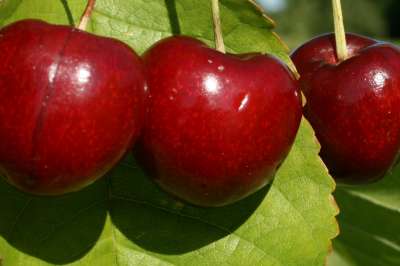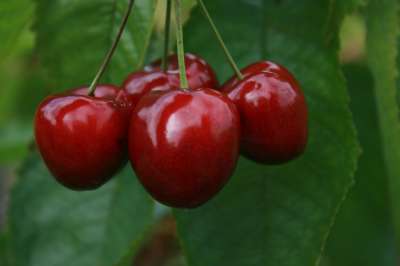Your basket is currently empty!
Despatch & Planting
We despatch all year round, usually within 3-5 working days of receipt. Trees are supplied bare-root Autumn-Spring and in containers/ex container from late Spring to Autumn.
Cropping time & yield is an estimate and can vary with conditions. Yield estimates based on mature trees.
Dwarfing Cherry Gisela ‘5’ stock
Has revoltutionised Cherry growing in the UK, not just in gardens but commercially as well. Makes a very easy to manage tree of just 6’+ in height & with a similar spread, crops early in life. Perfect for – Pots and containers, a small garden or smaller lawn and the fruit cage. Easy to net against birds and easy to harvest. The best garden rootstock for Cherries. Not all varieties are available on this stock yet – Sunburst, Stella, Summer Sun, Lapins, Morello, Merton Glory are the best ones that we have grafted onto Gisela 5. This stock does better with good soil.
Crops 1-2 years after planting.
Yield Estimate 20ibs+ with a required of area of 6×6’ minimum.[less when grown in a container]
Colt Cherry Rootstock
Semi-vigorous. Grows 10-12’ or so but can equally be controlled to less. Good for larger gardens, grass, orchard, paddock etc. Suitable also for a large half-barrel. Plant 10-12’ apart. Good heavy crops can easily be achieved & more tolerant of indifferent soil.
Crops 2-3 years after planting.
Yield Estimate 40ibs+ with a required minimum area of 8×8’.
Fan Cherry Trees
Often sought for wall planting as they grow flat. A fan has an outline rather like a dove tail, needs 6-8’ in height and the same spread. Plant 6-8’ apart. These trees are on ‘Colt’ stock, Gisela 5 generally does not make a good fan tree.
Crops 2-3 years after planting.
Yield Estimate 20ibs+
Supercolumn Cherry Trees
Are the most convenient and easy to prune trees for smaller gardens or where an intensive growing system is required. Supercolumns allow for a wide variety to be planted in a small area and have many applications around the garden. Plant just 2’ apart, in a row as free standing trees, or to align a path or walkway. Also ideal for planting against fence or wall where there is insufficient space for a fan tree. They can be grown in 18” containers, or used against archway or pergola. The growth is upright and slender, the fruits are borne all up the stem. Very easy to maintain and recommended to beginner and more experienced alike. The height is controllable but 6-8’ is usual.
Crops often the first year, or 1-2 years after planting.
Yield Estimate 3-4ibs with a required area of 24×24”.
Self Fertile Cherry Varieties
When it comes to growing cherries the dream often has to be tempered with a certain amount of practicality, foremost of which is that of space. Maybe you only have the room for one tree? Especially if you plan on growing a range of other fruit trees as well.
The sobering fact is that the majority of Cherry varieties are self-sterile. That is, they will set no useful crop with their own pollen, relying instead on other compatible varieties to help them out. Usually this involves selecting varieties of cherry that flower at approximately the same time; but frustratingly, incompatibility exists with some types, regardless of whether they produce useful pollen at the same time or not – so it can become a bit of a minefield! Even if you have other fruit trees it’s no use expecting an apple, or a pear for example, to help you out because different types of fruit don’t pollinate one another. A cherry has to be pollinated with another cherry.
But don’t worry, happily there is a select range of cherry trees that are happy living a solo life and it is these that we tend to recommend. Unless you really have a hankering for older varieties of cherry then it’s probably best to stick to these self fertile kinds anyway because they also happen to be more reliable which is most important, especially if you live in a colder area or are time-poor; cherries are often considered labour-intensive if you want to get the best from them. By planting more easy-going kinds you are assured of a certain amount of insurance and a decent crop most seasons.
These lovely self fertile varieties can be grown in all the usual ways that a cherry can be grown and there are options too for small gardens and the fruit cage. If you have a sunny wall then this is ideal because it’s easier to net the fruits from the birds, but it has to be a sunny south or west facing aspect as dessert cherries don’t thrive on easterly or northerly aspects. You will need an area of approximately not less than180cm’s in height and width to fan train a cherry tree.
The familiar bush tree can be grown as a more vigorous free standing specimen for lawn, grassy area or orchard and for this application you will need to select the colt rootstock because it is a bit more free growing; it can be mown-beneath, with a trunk clearance of 4’ or more. It will grow in excess of 10’ high but can be pruned. You will need the same in spread.
For a dwarfing free standing tree then the new Gisela 5 rootstock is a real boon to modern gardens because it’s much easier to control – I have seen many lovely little trees on this stock at no more than 6’ high and it is a precocious heavy cropper too. Probably the best choice of rootstock for everyday gardens, unless you want a bigger tree.
And if you’re really tucked for space then why not consider a column type tree? These are the easiest of all to grow, pruning is simple and you only need 18” in which to grow one because the trees don’t spread, maintaining a simple, upright, columnar form. Ideal also for pots, as well as the garden border.
Now to the varieties…
Sunburst Cherry Tree is the most well known and popular of all the cherries we grow. Its large black-red fruits have a great flavour and are freely produced. It’s ripening time is mid-season, in July. It does well on all the growing methods mentioned and is the first choice for most gardeners.
Summer Sun Cherry Tree is a good choice if you want fruits a little later because it follows on from Sunburst, ripening towards the end of July. Again the fruits are a dark reddish black with a similar ruby-black inner flesh that is juicy and sweet. A most satisfactory variety.







